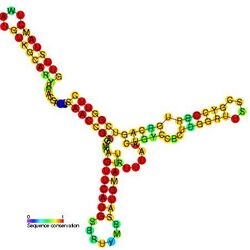Biology:Anti-Q RNA
| Anti-Q RNA | |
|---|---|
 Predicted secondary structure and sequence conservation of Anti-Q RNA | |
| Identifiers | |
| Symbol | Anti-Q_RNA |
| Alt. Symbols | QaRNA |
| Rfam | RF00388 |
| Other data | |
| RNA type | Gene; antisense |
| Domain(s) | Bacteria |
| SO | 0000644 |
| PDB structures | PDBe |
Anti-Q RNA (formerly Qa RNA) is a small ncRNA from the conjugal plasmid pCF10 of Enterococcus faecalis. It is coded in cis to its regulatory target, prgQ, but can also act in trans. Anti-Q is known to interact with nascent prgQ transcripts to allow formation of an intrinsic terminator, or attenuator, thus preventing transcription of downstream genes.[1][2] This mode of regulation is essentially the same as that of the countertranscript-driven attenuators that control copy number in pT181,[3] pAMbeta1[4] and pIP501[5] and related Staphylococcal plasmids.
Anti-Q is transcribed from the same segment of DNA as prgQ, except from the opposite strand, making it perfectly complementary to a portion of prgQ. Further experiments have experimentally confirmed the original consensus secondary structure and demonstrated that only certain regions of Anti-Q interact with prgQ.[6]
Anti-Q is derived from the 5’ end a longer transcript. The 3’ end of this transcript encodes PrgX, a repressor of prgQ transcription.
References
- ↑ Bae, T; Kozlowicz BK; Dunny GM (2004). "Characterization of cis-acting prgQ mutants: evidence for two distinct repression mechanisms by Qa RNA and PrgX protein in pheromone-inducible enterococcal plasmid pCF10". Mol Microbiol 51 (1): 271–281. doi:10.1046/j.1365-2958.2003.03832.x. PMID 14651627.
- ↑ "Direct evidence for control of the pheromone-inducible prgQ operon of Enterococcus faecalis plasmid pCF10 by a countertranscript-driven attenuation mechanism". J Bacteriol 192 (6): 1634–1642. 2010. doi:10.1128/JB.01525-09. PMID 20097859.
- ↑ "pT181 plasmid replication is regulated by a countertranscript-driven transcriptional attenuator". Cell 59 (2): 395–404. 1989. doi:10.1016/0092-8674(89)90300-0. PMID 2478296.
- ↑ "Countertranscript-driven attenuation system of the pAM beta 1 repE gene". Mol Microbiol 20 (5): 1099–1112. 1996. doi:10.1111/j.1365-2958.1996.tb02550.x. PMID 8809762.
- ↑ "RepR protein expression on plasmid pIP501 is controlled by an antisense RNA-mediated transcription attenuation mechanism". J Bacteriol 175 (13): 4052–4061. 1993. doi:10.1128/jb.175.13.4052-4061.1993. PMID 8320221.
- ↑ "Structural analysis of the Anti-Q-Qs interaction: RNA-mediated regulation of E. faecalis plasmid pCF10 conjugation". Plasmid 64 (1): 26–35. 2010. doi:10.1016/j.plasmid.2010.03.002. PMID 20332003.
External links
 |

